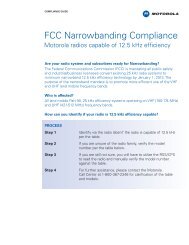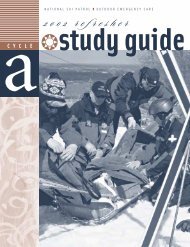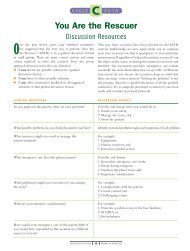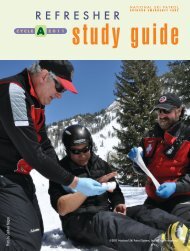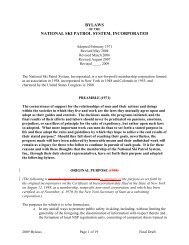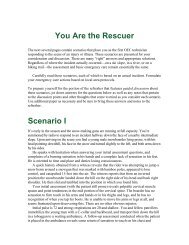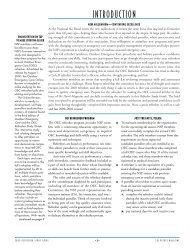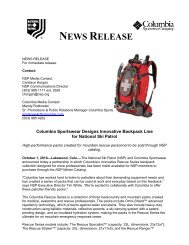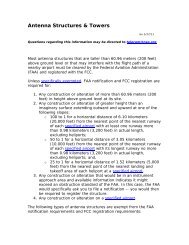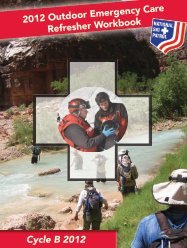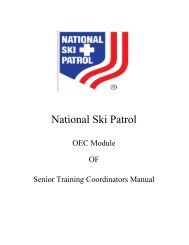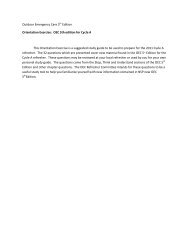Sierra Samaritans - National Ski Patrol
Sierra Samaritans - National Ski Patrol
Sierra Samaritans - National Ski Patrol
Create successful ePaper yourself
Turn your PDF publications into a flip-book with our unique Google optimized e-Paper software.
A bracing thought: Would the author have<br />
avoided a second ACL tear if he hadn’t retired<br />
his brace to the back of the closet after rehab<br />
got him back on skis?<br />
PHOTOS COURTESY OF MICHAEL PATMAS, MD<br />
❚ CONTINUED FROM PAGE 17<br />
ground ball and pivoted on my left leg to<br />
throw out a runner at home. My knee<br />
buckled like a sapling in gale force winds.<br />
I wasn’t wearing my brace at the time, and<br />
I knew at that moment that a second ACL<br />
reconstruction was inescapable. Whatever<br />
fibers might have been left after the tear<br />
the previous winter were certainly gone<br />
now. But by then I had lost my window of<br />
opportunity to have surgery before the<br />
ensuing ski season.<br />
As if possessed by the voice of folly, I<br />
actually opted to ignore the injury yet<br />
again. I knew that during the previous<br />
season the brace served as a great “external<br />
ACL” to make up for my damaged internal<br />
one. So, after going back to the closet to<br />
retrieve the brace, I completed the entire<br />
season without the ligament. My skiing<br />
did suffer, though. I found myself up<br />
against a psychological barrier: I couldn’t<br />
“let it rip,” so to speak.<br />
The doctors admitted that I could,<br />
conceivably, ski on my bad knee longer<br />
without having surgery, but I would eventually<br />
develop accelerated degenerative<br />
arthritis, which might limit me even more<br />
than the injury itself. So, I made the decision<br />
to have surgery one more time at the<br />
end of the season. I’m only 52 . . . a kid;<br />
I’m not ready to stop playing.<br />
My second surgery was a breeze. The<br />
doctor told me that, amazingly, all that<br />
was left of the first graft were a few hairlike<br />
fronds. The graft hadn’t torn, it had<br />
completely dissolved. What was even<br />
more amazing was that my meniscus was<br />
totally intact and unharmed. For the past<br />
season and a half, I had truly been skiing<br />
without an ACL. Typically, in such a situation<br />
the other knee structures will suffer<br />
additional damage, but I had none, most<br />
likely because the brace prevented the<br />
bones and other ligaments from rubbing<br />
against one another.<br />
Using a piece of my own hamstring,<br />
the doctors created and attached an ACL<br />
graft. Hopeful that the new graft would<br />
survive, they gave me a good prognosis<br />
after the second surgery. I was walking<br />
without crutches within a week, and after<br />
two weeks I was back in the gym and have<br />
been working out everyday since. I took<br />
classes—step, powerflex, running, spinning,<br />
weight training—effectively conducting<br />
my own physical therapy.<br />
The specter of another ACL reconstruction<br />
got me thinking about what I<br />
could do to avoid having to go through<br />
this a third time. My brace had served me<br />
well during two seasons without an ACL.<br />
Maybe I should never have taken it off,<br />
despite what the “experts” said. If I had<br />
been wearing it that day on the mountain<br />
and later at the baseball camp, maybe this<br />
wouldn’t have happened again. I found<br />
myself wondering, Is there any evidence<br />
that bracing can prevent re-rupturing<br />
the ACL? If so, why did all the experts<br />
and literature advise against it? I stopped<br />
wearing the brace after the first injury<br />
because conventional wisdom said I<br />
would become dependent on it. As it turns<br />
out, dependency might have been a better<br />
alternative. Had I done some more research<br />
back then, I might have continued wearing<br />
the brace.<br />
What The Researchers Say<br />
y quest for more information didn’t<br />
M take long at all, and what I found<br />
was quite interesting. This is a very controversial<br />
area with deeply held opinions<br />
and conflicting studies. What follows is an<br />
overview of the current evidence on the<br />
role of functional bracing in protecting<br />
the ACL-reconstructed knee, with particular<br />
emphasis on the skier.<br />
Despite more than 20 years of<br />
research, the role of knee bracing remains<br />
the subject of intense debate. Some doctors<br />
believe the brace should be worn while skiing<br />
for about one year after ACL reconstructive<br />
surgery to allow the ligament<br />
CONTINUED ON PAGE 20<br />
18 <strong>Ski</strong> <strong>Patrol</strong> Magazine | Winter 2005



